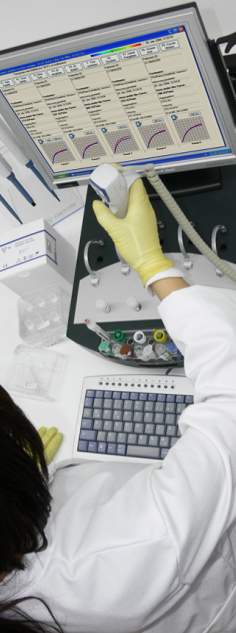|
|
Main Category: Blood / Hematology
Also Included In: Vascular; Clinical Trials / Drug Trials; Pharma
Industry / Biotech Industry
Abbott (NYSE: ABT) announced the expansion of the company's XIENCE
V(R) USA post-approval study designed to evaluate the safety and
effectiveness of the company's market-leading XIENCE V(R)
Everolimus Eluting Coronary Stent System in a real-world clinical
setting out to five years. The expansion allows for more than
2,000 patients from the XIENCE V USA trial to be eligible to cross
over into the landmark Dual Anti-Platelet Therapy (DAPT) Trial, an
industry-wide collaboration with medical device and pharmaceutical
companies.
"The expansion of the XIENCE V USA trial will enable Abbott to
enroll more than 2,000 patients who may be eligible to also
participate in the DAPT Trial to help advance the body of
scientific knowledge regarding the best duration for patients to
take blood-thinning medications after a stent procedure," said
Charles Simonton, M.D., FACC, FSCAI, divisional vice president,
Medical Affairs, and chief medical officer, Abbott Vascular. "We
anticipate the DAPT Trial results will be instrumental in
establishing definitive guidelines. As an industry leader, Abbott
is proud to play a significant role in contributing patients to
this important study."
The first patient was enrolled into the XIENCE V USA expansion by
James Hermiller, M.D., director, Cardiac Catheterization Labs, The
Care Group at St. Vincent Hospital in Indianapolis, Ind. Dr.
Hermiller is a principal investigator of the XIENCE V USA trial
along with Mitch Krucoff, M.D., FACC, FCCP, director,
Cardiovascular Devices Unit, Duke Clinical Research Institute in
Durham, N.C.
The XIENCE V USA trial expansion allows for an additional 3,000
patients to be enrolled into Abbott's study, which was originally
designed to study 5,000 patients in the United States. The primary
endpoint of XIENCE V USA is a measure of stent thrombosis every
year out to five years, as defined by the Dublin/Academic Research
Consortium (ARC). The ARC definition of late stent thrombosis was
developed to eliminate variability in the definitions across
various drug eluting stent trials.
About the DAPT Trial
The DAPT Trial is an independent, large-scale study in size
(20,000+ patients) and scope intended to determine the appropriate
duration for dual anti-platelet therapy (the combination of
aspirin and a second anti-clotting medication to reduce the risk
of blood clots) as well as the safety and effectiveness of DAPT to
protect patients from stent thrombosis and major adverse
cardiovascular and cerebrovascular events (MACCE) following the
implantation of either a drug eluting or bare metal stent.
The DAPT concept was developed by a consortium of eight companies
(four major stent manufacturers, including Abbott, and four
manufacturers of anti-platelet medications) who came together to
address a U.S. Food and Drug Administration (FDA) request for this
post-market study.
About XIENCE V
XIENCE V is used to treat coronary artery disease by propping open
a narrowed or blocked artery and releasing the drug, everolimus,
in a controlled manner to prevent the artery from becoming blocked
again following a stent procedure. XIENCE V is built upon Abbott's
market-leading bare metal stent, the MULTI-LINK VISION(R) Coronary
Stent System. The VISION platform is designed to facilitate ease
of delivery, making it easier for physicians to maneuver the stent
and treat the diseased portion of the artery.
The XIENCE V stent is available on both over-the-wire (OTW) and
rapid exchange (RX) delivery systems. Rapid exchange is the most
widely used type of delivery system because it provides physicians
additional flexibility to work as single operators during stent
procedures.
Abbott's market-leading XIENCE V drug eluting stent is marketed in
the United States, Europe and other international markets. XIENCE
V is an investigational device in Japan and is currently under
review by Japan's Ministry of Health, Labour and Welfare and the
Pharmaceuticals and Medical Devices Agency. It is also under
review with Health Canada.
Abbott also supplies a private-label version of XIENCE V to Boston
Scientific called the PROMUS(R) Everolimus-Eluting Coronary Stent
System. PROMUS is designed and manufactured by Abbott and supplied
to Boston Scientific as part of a distribution agreement between
the two companies.
Everolimus, developed by Novartis Pharma AG, is a proliferation
signal inhibitor, or mTOR inhibitor, licensed to Abbott by
Novartis for use on its drug eluting stents. Everolimus has been
shown to inhibit in-stent neointimal growth in the coronary
vessels following stent implantation, due to its antiproliferative
properties.
XIENCE V is indicated for improving coronary luminal diameter in
patients with symptomatic heart disease due to de novo native
coronary artery lesions (lesions
Abbott's market-leading XIENCE V drug eluting stent is marketed in
the United States, Europe and other international markets. XIENCE
V is an investigational device in Japan and is currently under
review by Japan's Ministry of Health, Labour and Welfare and the
Pharmaceuticals and Medical Devices Agency. It is also under
review with Health Canada.
Abbott also supplies a private-label version of XIENCE V to Boston
Scientific called the PROMUS(R) Everolimus-Eluting Coronary Stent
System. PROMUS is designed and manufactured by Abbott and supplied
to Boston Scientific as part of a distribution agreement between
the two companies.
Everolimus, developed by Novartis Pharma AG, is a proliferation
signal inhibitor, or mTOR inhibitor, licensed to Abbott by
Novartis for use on its drug eluting stents. Everolimus has been
shown to inhibit in-stent neointimal growth in the coronary
vessels following stent implantation, due to its antiproliferative
properties.
XIENCE V is indicated for improving coronary luminal diameter in
patients with symptomatic heart disease due to de novo native
coronary artery lesions with reference vessel diameters of 2.5 mm
to 4.25 mm.
|
|




